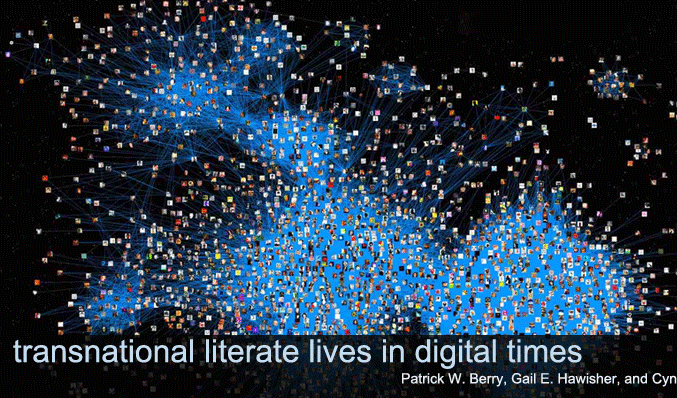PREFACE
Marilyn M. Cooper
When I was young, I never wanted to see photos of the authors whose books I read. I had an image of them from their books, and I was afraid I would be disappointed with the “real” thing. And when I saw one inadvertently, I sometimes was. Now—with so much news coming from television and online sources—it can be difficult to avoid seeing photos of and watching interviews with authors; as a result, much of that dissonance I felt as a child has been suppressed. For the most part, at least in humanistic disciplines, this is not the case. We seldom get such glimpses of research subjects in our professional journals and books. But in Transnational Literate Lives in Digital Times, not only are the “subjects” coauthors, but we get to meet them—if not as literally embodied people, then at least in photos and videos, located in visible places and countries. As the authors point out, our encounters with these young members of the “globalized eduscape” (C. Luke, 2006)—undergraduate and graduate students and teachers from around the world—are, as a result, “more richly textured.”
Here we get to meet, up close and personal, people like Kate Polglaze, who is studying pharmacology and Japanese at the University of South Wales, who maintains online friendships all over the world (Japan, Canada, London, Malaysia), and who writes fan fiction focused on Japanese culture. In video clips from her interview, we can hear in her voice that she is from Australia, and she smiles when she describes Japanese boy bands as “my current obsession.” And Pengfei Song, who illustrates his literacy narrative with a high-angle rendering of the farm house in the Peoples Republic of China where he lived as a child and a photo of a house like it. In lengthy excerpts from his narrative, we learn that his family “had very little money” and that they used the trees in the yard to make furniture and as a source of food (leaves and flowers). At the time when he recounted his narrative, he was a graduate student in biochemistry at Michigan Technological University, communicating with his family in China via the computer that cost them half a year’s salary. Though we do not hear his voice, we also see photos of Pengfei as a student at Michigan Tech and at the Changlong Zoo in Guangzhou, and in the last section of the chapter containing his narrative we are encouraged to contemplate the fragility of success stories such as Pengfei’s.
As pointed out in the concluding thoughts on research methodology, the additional semiotic information available when research is collected and presented in multimodal formats makes the accounts more “complete, accurate, and informative.” Supplied with the voices of the coauthors, their intonation patterns and body language, images of them and their surroundings, and videos and images the coauthors have made, readers can better interpret the text of the narratives and can better assess the conclusions drawn from the research. Thus, in addition to broadening our understanding of how digital literacies are being taken up in cultural, political, and economic circumstances beyond the borders of the United States, Transnational Literate Lives in Digital Times is a powerful argument for the value of digital video and audio research methods.
As a consequence, it also contributes to the discussion of the ontological status of virtual communication. When we meet Kate and Pengfei—and Gorjana, Mirza, Tessa, Shafinaz, Sophie, Yu-Kyung, Vanessa, Ismael, Hannah, Dipo, and Synne—in this way, do we encounter them as “real” people? They are certainly more embodied and located than had we met them only in alphabetic text. But does the digital interface mediate our understanding of them in a way different from face-to-face encounters? If so, does the difference matter? And how?
I do not mean by these questions to suggest a return to the liberal humanist paradigm of originary presence and objectivism (cf. Hayles 285-88). Nor do I mean to contest that mediated intimacy is a construct (Wilding 133). But recent research on human-animal communication such as Donna Haraway’s account of working with her dog in the sport of agility suggests that modalities not available online (smell, touch) as well as interactional responses are also significant sources from which we construct our sense of those whom we meet. The failure to include these aspects in observational studies is not restricted to research conducted and presented with digital media. Instead, it is a signal virtue of digitally mediated research that just by its more richly textured presentation of subjects it highlights the limitations of all presentations—as well as the complexity—of “real” people.
References
Haraway, Donna J. (2008). When species meet. Minneapolis: University of Minnesota Press.
Hayles, N. Katherine. (1999). How we became posthuman: Virtual bodies in cybernetics, literature, and informatics. Chicago: University of Chicago Press.
Wilding, Raelene. (2006). "Virtual" intimacies? Families communicating across transnational contexts.
Global Networks, 6(2), 125-142.
previous < > ACKNOWLEDGMENTS














